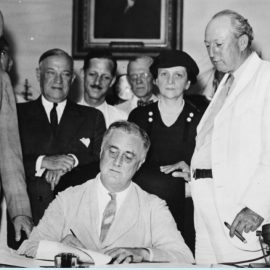

This article is an excerpt from the Shortform book guide to "The Wolf of Wall Street" by Jordan Belfort. Shortform has the world's best summaries and analyses of books you should be reading.
Like this article? Sign up for a free trial here.
What were the consequences of Jordan Belfort’s lifestyle? How did Belfort try to escape from Stratton Oakmont during a criminal investigation?
Even though Belfort went to prison for financial misdealings, it was his excessive lifestyle that almost destroyed him before the law caught up. Belfort’s addictions to drugs, sex, and risk-taking behavior continue to dominate his life even after he left Stratton Oakmont behind.
Learn how Belfort’s “early retirement” became a downward spiral of drug use, depression, and self-destruction.
The Getaway Attempt
The consequences of Jordan Belfort’s lifestyle start with his leave from Stratton Oakmont. In 1994, the SEC offered Belfort a deal that would have given him an escape from Stratton Oakmont and its whirlwind of chaos. The SEC agreed to end its criminal investigation if Belfort stepped away from his firm and left securities trading for good. Belfort would reluctantly take the SEC’s deal, but he wouldn’t honor it in spirit—instead setting himself up as an outside adviser who’d help to steer Stratton Oakmont from behind the scenes.
After years of trying to pin Stratton Oakmont down for stock manipulation, the SEC grew tired of pursuing its case and offered to let Belfort settle out of court if he agreed to a token $3 million fine and to leave the brokerage industry forever. Belfort writes that he didn’t believe the SEC had a solid case to make against him, but his lawyers persuaded him that if the investigation kept going on, it would eventually turn up something damning. Therefore, he agreed to step aside and hand the reins of the firm to Danny Porush, who’d always been his right-hand man—and whose wild behavior outmatched Belfort’s. Belfort would be free to enjoy his fortune, along with his wife, his young children, and their friends.
(Shortform note: To be clear, the SEC cannot bring criminal charges against people like Belfort whom it investigates, but it works in tandem with the US Department of Justice in cases where criminal actions may be involved. However, because of the lack of prosecutions after the 2008 financial crisis, many people believe that the Justice Department and the SEC go easy on so-called “white collar crime.” In Big Dirty Money, Jennifer Taub contends that the legal system uses a skewed outlook on financial criminality that targets low-level Wall Street employees while letting those higher up the ladder off the hook.)
More than just an escape from prosecution, the SEC’s deal could have given Belfort a graceful exit from the extravagant culture he’d created, but the thought of leaving the stock trading business never crossed Belfort’s mind. Rather, Belfort chose to stay in the game as a private investor while setting up an office next door to Stratton Oakmont, acting as the firm’s back-room adviser. Belfort says he was overjoyed that he’d no longer have to trade stock through proxies—as a private individual, he’d be able to trade as much as he wanted without having to hide his transactions.
(Shortform note: Belfort’s reluctance to leave trading behind points to the broader question of why the wealthy don’t simply retire once they’ve earned more money than they could ever spend. One reason is that many successful businessmen are afraid that the businesses they built might fail if they give up control to someone else. Others worry about adjusting to a life without the structure and sense of personal fulfillment that their careers provide. For some of the wealthiest people, however, their entire sense of social status and self-worth is tied up in how much money they make—they can’t ever slow down because to do so would mean losing status in the eyes of their ultra-wealthy peers.)
Alas, Belfort writes that all wasn’t well in his new paradise. Madden, Belfort’s proxy owner of Steve Madden Shoes, began to show signs that he wouldn’t turn over the stock he’d been holding on Belfort’s behalf. Meanwhile, Belfort started hearing rumors about Porush’s mismanagement of Stratton Oakmont. To top it all off, as soon as the SEC investigation closed, Belfort learned that the FBI had begun its own investigation—this one aimed at him and not his former firm.
The Downward Spiral
Despite Belfort’s previous assertion that money was able to solve any problem, his riches did nothing but fuel his drug use and enabled him to endanger himself in ways that only the super-wealthy can. Belfort recounts his worsening drug addiction, the self-destructive behavior it inspired, and the damage done to his family life, and his head-on collision with depression and attempted suicide before giving in to professional help.
Belfort says that while he’s done many drugs, his primary addictions were to sex and to methaqualone, commonly known as “Quaalude,” which was prescribed to him after a back injury. He eventually became hooked on the pills and used them for their high instead of pain relief. Belfort was on a particularly strong Quaalude high when he learned that the FBI was after him for money laundering. He rushed home, delirious on drugs, crashed into seven cars, and injured one person. For once, the police arrested Belfort, though as always before, he suffered no consequences—this time thanks to a friend who knew a judge.
In 1996, Belfort’s doctors found a way to treat his pain without the use of Quaaludes, but that didn’t stop Belfort from using them. He, his wife, and their friends went to Rome, where he and his friends were so high on drugs that Belfort insisted his yacht be put to sea in the face of an oncoming storm. The storm turned into a massive gale with 50-foot waves, endangering the lives of everyone onboard, though Belfort recalls that he and his friends prioritized saving their drugs over themselves. The Italian navy rescued Belfort and his crew shortly before his yacht sank in the storm, and even though Belfort would not be held accountable, he promised himself and his wife he’d quit the Quaaludes.
Rock Bottom and Recovery
Belfort had hit the lowest point of his life. Since drugs had become his only refuge, he couldn’t see any way out of his situation that didn’t involve drugs as part of the solution. Belfort describes his head-on collision with depression and attempted suicide before giving in to professional help, as well as the peace and self-awareness that came after.
In a fit of anger and depression, Belfort attempted suicide by taking morphine pills, though he argues that it wasn’t a real suicide attempt because he knew a friend of his was near and would be able to save him. After having the morphine pumped out of his system, Belfort was placed on an involuntary psychiatric hold, during which Nadine arranged for an intervention—she let Belfort know that unless he went to rehab, he’d never see her again. Belfort’s interventionist explained that he and Nadine were deeply codependent in that she’d been enabling his rampant drug use while he took advantage of his power in their marriage.
Once in rehab, Belfort asserts that his urge to do drugs simply turned itself off, though he felt his sex addiction would remain more of a problem. He slowly opened up to his fellow rehab patients, while admitting to himself that he ought to be dead from the sheer amount of drugs he’d been taking. He returned to New York where he was able to stay sober, though his recovery sponsor pointed out to him that even though he’d stopped using drugs, he was still in danger of repeating the behaviors that he’d used the drugs to justify.
Nevertheless, Belfort recalls that those first sober months were the clearest, happiest, and healthiest he’d had in over 10 years. He worked on trying to repair his marriage, spend time with his children, and explore his new reality. Many of his old friends drifted away, and his relationships with the ones who stayed changed. Stratton Oakmont had long since closed down, and Belfort’s other financial streams folded. He didn’t care—he was sober, rich, and happy—until September 1998, when the FBI arrested him for money laundering and fraud, shortly after which, Nadine filed for divorce.

———End of Preview———
Like what you just read? Read the rest of the world's best book summary and analysis of Jordan Belfort's "The Wolf of Wall Street" at Shortform.
Here's what you'll find in our full The Wolf of Wall Street summary:
- How Jordan Belfort grew his wealth through stock manipulation and money laundering
- How Belfort's lifestyle of drug abuse and self-indulgence almost killed him
- Proof that money can't buy happiness






